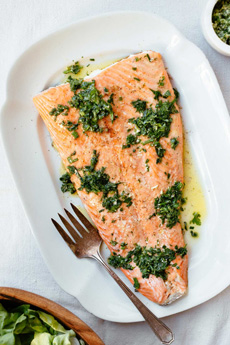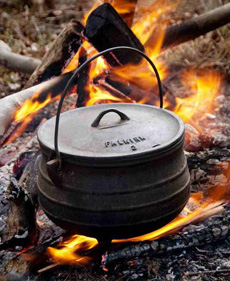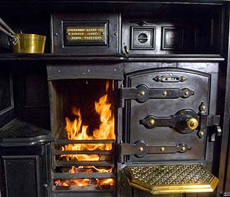RECIPE: A Simple Salmon Dinner & The History Of Oven Cooking
 [1] Spoon the herb butter sauce over the fillet.
|
Last night we had guests over for a simple salmon dinner. It was an impromptu event: Our fishmonger had a sale on wild-caught salmon and we decided it would be a “salmon weekend.”
We adore complicated recipes in the right hands. When we dine out, it is usually to have food from gifted chefs whose technique to make it surpasses anything we could hope to achieve. But at home, we tend to keep things simple. The best ingredients, simply prepared to show them off, create the best meals. While many people say they can’t cook fish well, baking it is pretty fool-proof (as it is tossing a marinated fish on the grill, if you have one). This easy recipe from Good Eggs, bakes the salmon in a slow oven (see the chart below), to “gently coax out the salmon’s delicate flavor.” Add a simple green salad and a steamed fresh vegetable and you’ve got a delicious dinner. Everything will be ready in 35 minutes. Where would we be without our ovens? The history of the oven is below. The best wine pairings are chosen by preparation, not by ingredient. A classic wine pairing for salmon baked in butter sauce is Chardonnay/White Burgundy. You can also serve rosé or a sparkling wine. We served a luscious Pinot Gris* from our favorite Alsatian producer, Zindt-Humbrecht, and a Grüner Veltliner (a superb Austrian white) from Pichler. Sauvignon Blanc is another favorite. Red wine is typically paired with a meatier preparation, such as grilled or blackened salmon. But if you only drink red, a light Pinot Noir/Red Burgundy, Gamay/Beaujolais, or Valpolicella Classico will work. National Salmon Day is October 8th and National Bagel And Lox Day is February 9th. > Check out more salmon holidays below. The recipe follows. Elsewhere on The Nibble, check out: > The year’s 56 fish and seafood holidays. > The different types of fish and seafood: a photo glossary. Ingredients For 2-3 Servings |
|
|
________________ *Pinot Gris is a white wine grape now planted around the world, but originally known by the wines from Alsace, France. Pinot Grigio is Italian for the same grape. Pinot Blanc is very similar: Both grapes (Pinot Gris/Grigio and Pinot Blanc) are mutations of Pinot Noir. Alsatian Pinot Gris tends to be a more finely crafted wine. While there are fine Pinot Grigios, much of what is sold in the U.S. is a lighter, mass-market wine. †A handful is one of those imprecise measures that says: Use how much you want. More or less of the ingredient is not critical to the recipe’s outcome. |
||
|
Preparation
1. PREHEAT the oven to 225°F. While it heats, make a simple herb butter by combining the basil leaves with the butter. If you have other herbs in the kitchen—parsley, tarragon, etc.— feel free to add them also. 2. PLACE the salmon fillet(s) on a parchment-lined baking sheet. Season it lightly with salt and pepper, and scoop a few dollops of herb butter over it. Then bake it for about 30 minutes, until it is just barely firm to the touch. While fish bakes… 3. MAKE the salad dressing. Place the onion in a bowl, cover it with the vinegar, and let sit for about 15 minutes. Then whisk in the olive oil with, a pinch of salt and freshly ground pepper to taste. When fish is done… 4. REMOVE the fish from the oven and let it rest for a minute as you make the salad. Toss the lettuce with the vinaigrette, sliced avocado and a few torn basil leaves; serve with a big piece of salmon and a glass of nicely chilled wine. When early man mastered the creation of fire, food was cooked in pits dug into the ground, over flame-heated stones, and then—with the invention of cooking vessels—suspended over fires. Cooking was at best imprecise, but so was all of life back then. When nomadic man settled into agricultural communities, an outdoor or indoor fireplace could be constructed; an indoor fireplace also provided heat in colder climates. All cooking was still approximate in terms of how large a fire was needed, and how long to cook the food. In those days, food was sustenance rather than cuisine. Fire was used to make tough foods more chewable. In earlier times before ovens had sophisticated temperature controls, it was a challenge for cooks to make temperature-sensitive recipes. Even in recipes from the early 20th century, you’ll find directions like “cook in a slow oven for 2 hours or until meat is tender.” Today, ovens have precise temperature controls and those general times have been converted to degrees. For example, a “moderate oven” is 350°F to 375°F. This history of ovens is adapted from an article in Smithsonian Magazine by Lisa Bramen. Before ovens, there was cooking over an outdoor fire (think campfire) or an indoor fireplace and chimney with pots suspended over a wood fire. |
|
|
|
CHECK OUT WHAT’S HAPPENING ON OUR HOME PAGE, THENIBBLE.COM. |
||








